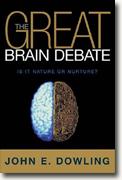The Great Brain Debate
John E. Dowling
book reviews:
· general fiction
· chick lit/romance
· sci-fi/fantasy
· graphic novels
· nonfiction
· audio books
· author interviews
· children's books @
curledupkids.com
· DVD reviews @
curledupdvd.com
newsletter
win books
buy online
links
home
for authors
& publishers
for reviewers

 |
The Great Brain Debate: Is It Nature or Nurture? John E. Dowling Joseph Henry Press Hardcover 189 pages October 2004 |
|
Dr. John E. Dowling, former Harvard Professor in Neuroscience, member of the National Academy of Sciences, and current President of the Corporation of Marine Biological Laboratory in Woods Hole, Massachusetts, sets out in The Great Brain Debate a simple description but intriguing introduction to the complex structure and dynamic functions of the developing human brain.
Interesting facts abound in the book - chimpanzees make 36 distinct sounds while English-speakers have 52 phonemes and may use 80,000 words in a complex, proactive verbal and nonverbal vocabulary. The author (see Figure 4-5 A) outlines major synaptic pathways in the hippocampus which activate granule cells which synapse on CA3 pyramidal neurons, which go on to innervate axonal branches from the CA3 neurons to CA1 pyramidal neurons. The cellular processes appear to be major outputs to the hippocampus in the process of stimulating and strengthening the synapses on the cell. This process is called “long-term potentiation,” or LTP, implicated in strengthening human memory, learning, and recall outcomes. Humans are different from other living species in their ability to discriminate sounds, attach, recall, and manipulate symbolic meanings, and physical movements within and between each individual’s complex grid of personal, constructive memory, culture, experiential life and expressive behavioral performances. However, brain “plasticity,” “nurturing environment,” “growth,” and “emergent development” go undefined. The author appears to reduce the questions raised to reference largely unseen but labeled INTERNAL phenomena of cell life. He describes cell division, migration, search, connections, and missed connections, with receptor cells, neurons, synapses, axons, dendrites, and clusters of different, biochemical systems. He takes into account a few of these respective cell outcomes including cell loss, cell clustering, cell dysfunction, cell tangles, and cell waste (e.g., in neuro-degenerative Alzheimer’s and Parkinson’s diseases). The EXTERNAL cell “environment” that we typically think of (including clean air, eating, nutrition, parenting, family support, learning, stressful events, and enriching contextual life experiences) interacting with and “nurturing” human personality, physical/ perceptual/emotional/immune system developments and every day behavior appear not to be explicitly or systematically considered. Descriptions of cutting out specific parts of the brain or visual and sound location systems in birds, owls, cats, rats, and monkeys may be biologically fascinating in their own right, but instead of total losses in physical function, this reader wanted to learn more about proactive, controllable and conscious changes in human functioning that can be better understood and possibly initiated to accelerate human development and compensate for physical (e.g., genetic/ chemical) losses of short and longer-term expressions and/or suppressions of functions. The difficulty level of The Great Brain Debate: Is It Nature or Nurture? is slanted heavily towards “nature” over “nurture” and promises far more than the average thinking person can comprehend and focus on without the comparative and longitudinal research data. Maybe the reader has the background and training necessary to address the author’s proposed questions. Conceptual analogies to human beings through comparative, operational concepts like “nurturing,” “stimulating,” and “toxic” sets of variable relationships in corresponding human research studies are not considered or discussed in depth. A reference list of twelve books on the brain is provided for further reading. However, meta-research reviews, bibliography of research studies cited in the book, or contrasting perspectives on “environment,” “development, ”intelligence,” “changes” in function and spontaneous behavior are missing. The book is an interesting, thought-provoking introduction to the evolving field of human genetics and potentially applied neuro-psychology. Originally published on Curled Up With A Good Book at www.curledup.com. © David L. Johnson, Ph.D., 2006 |
|
|
|
 Click here to learn more about this month's sponsor! |
|
| fiction · sf/f · comic books · nonfiction · audio newsletter · free book contest · buy books online review index · links · · authors & publishers reviewers |
|
| site by ELBO Computing Resources, Inc. | |
 The author raises a number of long-standing questions: How much and what
kinds of human behavior are determined by our genes (individually or in clusters),
and how much and which expressed behavior are developed by environment?
How much plasticity, language, learning, memory, recall, and potential problem-
solving capabilities are there within an adjusting or developing brain in a given
individual life span and collectively in all humans over 150,000 years?
The author raises a number of long-standing questions: How much and what
kinds of human behavior are determined by our genes (individually or in clusters),
and how much and which expressed behavior are developed by environment?
How much plasticity, language, learning, memory, recall, and potential problem-
solving capabilities are there within an adjusting or developing brain in a given
individual life span and collectively in all humans over 150,000 years?